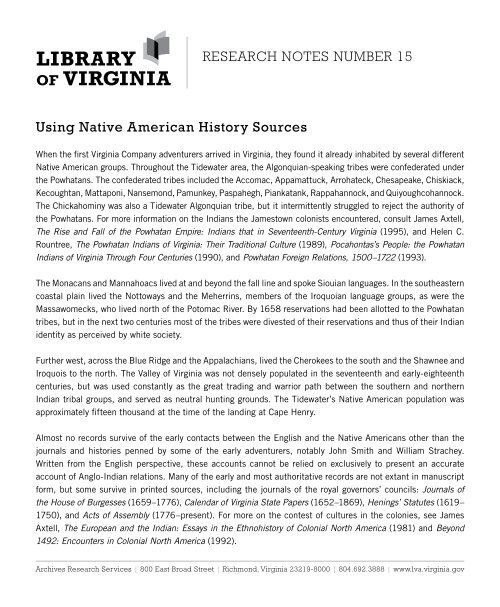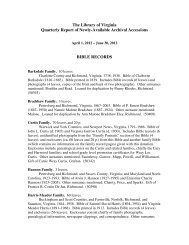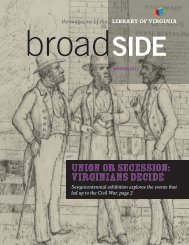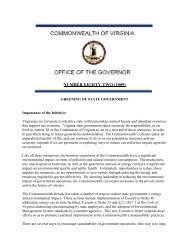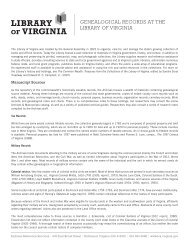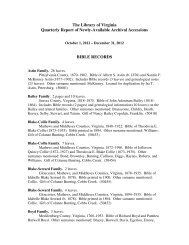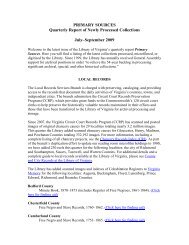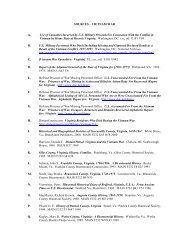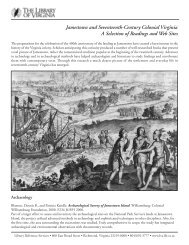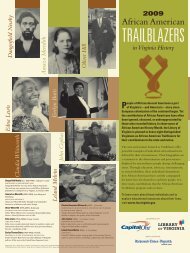Using Native American History Sources - Library of Virginia
Using Native American History Sources - Library of Virginia
Using Native American History Sources - Library of Virginia
You also want an ePaper? Increase the reach of your titles
YUMPU automatically turns print PDFs into web optimized ePapers that Google loves.
Research notes number 15<strong>Using</strong> <strong>Native</strong> <strong>American</strong> <strong>History</strong> <strong>Sources</strong>When the first <strong>Virginia</strong> Company adventurers arrived in <strong>Virginia</strong>, they found it already inhabited by several different<strong>Native</strong> <strong>American</strong> groups. Throughout the Tidewater area, the Algonquian-speaking tribes were confederated underthe Powhatans. The confederated tribes included the Accomac, Appamattuck, Arrohateck, Chesapeake, Chiskiack,Kecoughtan, Mattaponi, Nansemond, Pamunkey, Paspahegh, Piankatank, Rappahannock, and Quiyoughcohannock.The Chickahominy was also a Tidewater Algonquian tribe, but it intermittently struggled to reject the authority <strong>of</strong>the Powhatans. For more information on the Indians the Jamestown colonists encountered, consult James Axtell,The Rise and Fall <strong>of</strong> the Powhatan Empire: Indians that in Seventeenth-Century <strong>Virginia</strong> (1995), and Helen C.Rountree, The Powhatan Indians <strong>of</strong> <strong>Virginia</strong>: Their Traditional Culture (1989), Pocahontas’s People: the PowhatanIndians <strong>of</strong> <strong>Virginia</strong> Through Four Centuries (1990), and Powhatan Foreign Relations, 1500–1722 (1993).The Monacans and Mannahoacs lived at and beyond the fall line and spoke Siouian languages. In the southeasterncoastal plain lived the Nottoways and the Meherrins, members <strong>of</strong> the Iroquoian language groups, as were theMassawomecks, who lived north <strong>of</strong> the Potomac River. By 1658 reservations had been allotted to the Powhatantribes, but in the next two centuries most <strong>of</strong> the tribes were divested <strong>of</strong> their reservations and thus <strong>of</strong> their Indianidentity as perceived by white society.Further west, across the Blue Ridge and the Appalachians, lived the Cherokees to the south and the Shawnee andIroquois to the north. The Valley <strong>of</strong> <strong>Virginia</strong> was not densely populated in the seventeenth and early-eighteenthcenturies, but was used constantly as the great trading and warrior path between the southern and northernIndian tribal groups, and served as neutral hunting grounds. The Tidewater’s <strong>Native</strong> <strong>American</strong> population wasapproximately fifteen thousand at the time <strong>of</strong> the landing at Cape Henry.Almost no records survive <strong>of</strong> the early contacts between the English and the <strong>Native</strong> <strong>American</strong>s other than thejournals and histories penned by some <strong>of</strong> the early adventurers, notably John Smith and William Strachey.Written from the English perspective, these accounts cannot be relied on exclusively to present an accurateaccount <strong>of</strong> Anglo-Indian relations. Many <strong>of</strong> the early and most authoritative records are not extant in manuscriptform, but some survive in printed sources, including the journals <strong>of</strong> the royal governors’ councils: Journals <strong>of</strong>the House <strong>of</strong> Burgesses (1659–1776), Calendar <strong>of</strong> <strong>Virginia</strong> State Papers (1652–1869), Henings’ Statutes (1619–1750), and Acts <strong>of</strong> Assembly (1776–present). For more on the contest <strong>of</strong> cultures in the colonies, see JamesAxtell, The European and the Indian: Essays in the Ethnohistory <strong>of</strong> Colonial North America (1981) and Beyond1492: Encounters in Colonial North America (1992).Archives Research Services | 800 East Broad Street | Richmond, <strong>Virginia</strong> 23219-8000 | 804.692.3888 | www.lva.virginia.gov
Research notes number 15Thousands <strong>of</strong> references documenting the affairs <strong>of</strong> <strong>Virginia</strong>’s <strong>Native</strong> <strong>American</strong>s through three centuries surviveand are available for research at the <strong>Library</strong> <strong>of</strong> <strong>Virginia</strong>. Overall, they illustrate the discrimination, to a greateror lesser degree, that was the social and legal inheritance <strong>of</strong> <strong>Virginia</strong>’s <strong>Native</strong> <strong>American</strong>s from contact to thepresent century, and the <strong>Native</strong> <strong>American</strong>s’ continuing attempts to manipulate the boundaries that white societyset for them.There is no central collection <strong>of</strong> all materials on <strong>Virginia</strong>’s Indians, nor is there one comprehensive index to the<strong>Library</strong>’s holdings. Records are not arranged by tribal affiliation. A variety <strong>of</strong> sources may be found in manydifferent collections, such as printed materials, micr<strong>of</strong>ilm, and original manuscripts. A selected bibliography <strong>of</strong>printed sources on <strong>Native</strong> <strong>American</strong>s is available from <strong>Library</strong> Reference. The online Archives and ManuscriptsCatalog may be searched with the general keyword “Indian.” For additional information on holdings, see“Resources on <strong>Native</strong> <strong>American</strong>s at the <strong>Library</strong> <strong>of</strong> <strong>Virginia</strong>,” a topical bibliography available in the West ReadingRoom and on the <strong>Library</strong>’s Web site. Specific collections are described in a reference binder located in theArchives Research Room.<strong>Virginia</strong> Colonial Records ProjectMany extant early manuscripts are held in repositories in Great Britain, particularly in the Public RecordOffice, including records <strong>of</strong> the Colonial Office, the Admiralty, and the Board <strong>of</strong> Trade. The staff <strong>of</strong> theColonial Records Project located and surveyed these documents. A searchable database and digital images<strong>of</strong> the survey reports are on the <strong>Library</strong>’s Web site. Approximately two-thirds <strong>of</strong> the original documents havebeen micr<strong>of</strong>ilmed and are available in the West Reading Room and through interlibrary loan. Perhaps the mostsignificant <strong>Native</strong> <strong>American</strong> document is the 1677 Treaty <strong>of</strong> Middle Plantation, signed by <strong>Virginia</strong>’s governoron behalf <strong>of</strong> the British government and by several Indian chieftains. This treaty still directs <strong>Virginia</strong>’s <strong>of</strong>ficialrelationship with the reservation tribes. The original is in Great Britain, but a micr<strong>of</strong>ilmed copy is availableat the <strong>Library</strong> <strong>of</strong> <strong>Virginia</strong> on the <strong>Virginia</strong> Colonial Records Project Reel 93 (Survey Report 00661, PROClass C.O. 1/40, folios 202–212). Other documents include discussions on trade with the Indians, reportsfrom missionaries, letters from <strong>of</strong>ficials, and petitions from <strong>Native</strong> <strong>American</strong>s to their British overlords. Foradditional information, see Research Note 7.Colonial PapersThis rich and diverse collection contains varied materials relating to <strong>Native</strong> <strong>American</strong>s. Seventeenth-centuryrecords most <strong>of</strong>ten relate to the Algonquian tribes <strong>of</strong> the Tidewater. The westward expansion <strong>of</strong> English settlementin the mid-eighteenth century increased the number <strong>of</strong> records relating to the tribes <strong>of</strong> the Blue Ridge andbeyond the Appalachians. Among the many records in this collection are the 1706 petition <strong>of</strong> the Pamunkeys tothe governor, and two depositions from 1754 concerning Indian depredations in Augusta County. Each record isnow separately cataloged as a subject heading and is searchable in the online Archives and Manuscripts Catalog.The records are on miscellaneous micr<strong>of</strong>ilm reels 609–612.
3Local RecordsInformation on <strong>Native</strong> <strong>American</strong>s can also be mined from county and municipal records. Although they livedthroughout the Tidewater area in 1607, the Powhatan tribes were forbidden by a 1646 treaty to live between theJames and York rivers, and were temporarily guaranteed complete freedom to dwell between the Rappahannockand the York rivers on the Middle Peninsula. The counties <strong>of</strong> the Middle Peninsula, the Northern Neck, and theEastern Shore are the richest sources <strong>of</strong> early records. Most <strong>of</strong> the reservations were located in those counties,and even when the majority <strong>of</strong> the tribes lost their lands, members <strong>of</strong>ten stayed in the area. Most <strong>of</strong> the MiddlePeninsula counties have suffered record losses, but the Northern Neck and some <strong>of</strong> the Southside countiesare valuable areas for research. The records <strong>of</strong> Amherst, Augusta, and Rockbridge counties also provide manyreferences to <strong>Native</strong> <strong>American</strong> life.Within the local records are numerous references to <strong>Native</strong> <strong>American</strong>s, located most <strong>of</strong>ten in the order andminute books <strong>of</strong> the county court. Deed and will books occasionally contain related materials. The order books<strong>of</strong> Lancaster, Northumberland, and Old Rappahannock counties in the Northern Neck, and Southampton andNorfolk counties in the Southside, are particularly useful, as are the order books for Northampton County onthe Eastern Shore. These are available on micr<strong>of</strong>ilm at the <strong>Library</strong> <strong>of</strong> <strong>Virginia</strong> and through interlibrary loan. Seethe <strong>Library</strong>’s Web site for a complete listing <strong>of</strong> local records on micr<strong>of</strong>ilm. Some records from the lost recordscounties <strong>of</strong> King William (site <strong>of</strong> the two remaining reservations) and King and Queen have been transcribed,printed, and micr<strong>of</strong>ilmed.Legislative PetitionsSince before the <strong>American</strong> Revolution, <strong>Virginia</strong>ns have petitioned the legislature for assistance, appointments, andgovernmental action. Petitions are filed alphabetically by county and then chronologically. Because they had beensent to Richmond, petitions survive even for lost record counties. Researchers may examine petitions for countieswhere <strong>Native</strong> <strong>American</strong>s were concentrated, including Charles City County, James City County, King WilliamCounty, and the Northern Neck counties. Among the notable are the petition initiated by Thomas Gregory, <strong>of</strong> KingWilliam, in 1843, requesting the sale <strong>of</strong> both remaining reservations, and a counterpetition by the Pamunkey tribe.The petitions are on micr<strong>of</strong>ilm and a searchable database is available on the <strong>Library</strong>’s Web site.State RecordsMany references to <strong>Native</strong> <strong>American</strong>s appear in the Executive Papers, particularly in the Office <strong>of</strong> the Governor,Letters Received, 1776–1906, and Letters Received and Sent, 1906–1998. Copies <strong>of</strong> the letters received bythe governor for the period 29 June 1776–30 November 1784 are available on the <strong>Library</strong> <strong>of</strong> <strong>Virginia</strong> Web siteand are fully searchable. They are also on micr<strong>of</strong>ilm and available from interlibrary loan. Other governors’ papersare also available on micr<strong>of</strong>ilm or in original form. Many have been cataloged and have guides available in theonline Archives and Manuscripts Catalog.
The state records collection also contains twentieth-century files from <strong>Virginia</strong>’s two reservation Indian schoolsin the <strong>Virginia</strong> Department <strong>of</strong> Education Collection. <strong>Native</strong> <strong>American</strong>s served in the First World War and areincluded in the <strong>Virginia</strong> War <strong>History</strong> Commission questionnaires, available on micr<strong>of</strong>ilm and on the <strong>Library</strong>’sWeb site. Other series <strong>of</strong> state records, such as those <strong>of</strong> the Auditor <strong>of</strong> Public Accounts, may also prove usefulin researching <strong>Native</strong> <strong>American</strong>s.Census RecordsSurviving <strong>Virginia</strong> census schedules begin in 1810 and are available through 1930 at the time <strong>of</strong> this printing.The term Indian (<strong>Native</strong> <strong>American</strong>) first appears in 1870 as a separate category for race. In the 1900 and1910 census <strong>of</strong> King William County, Indians living on the two reservations were counted separately asIndians, rather than under the usual “people <strong>of</strong> color” designation. The list is found at the end <strong>of</strong> the “WestPoint District” section in each census. Indian students at Hampton Institute were likewise listed in the censuswith their tribal affiliations.Personal PapersPersonal Papers collections include a variety <strong>of</strong> material relating to <strong>Native</strong> <strong>American</strong>s, including reminiscences<strong>of</strong> the <strong>Virginia</strong> frontier during the French and Indian War, mid-twentieth-century work on <strong>Native</strong> <strong>American</strong>genealogy, and tribal organization papers from the 1980s. The James Coates Papers (Accession 31577)contain copies <strong>of</strong> many <strong>of</strong> the letters and documents generated by Bureau <strong>of</strong> Vital Statistics registrar WalterA. Plecker in his antimiscegenation campaign. Researchers can access these collections through the Archivesand Manuscripts Catalog by searching the general keyword “Indian.” For additional information on holdings,see “Resources on <strong>Native</strong> <strong>American</strong>s at the <strong>Library</strong> <strong>of</strong> <strong>Virginia</strong>,” a topical bibliography. Specific collections aredescribed in a reference binder located in the Archives Research Room.Vertical FileArchivists at the <strong>Library</strong> <strong>of</strong> <strong>Virginia</strong> have collected newspaper and journal references and miscellaneousdocuments on <strong>Virginia</strong>’s <strong>Native</strong> <strong>American</strong>s throughout the twentieth century. These vertical files are diverse,containing letters to Governor Colgate Darden from residents <strong>of</strong> the Pamunkey and Mattaponi reservations,handwritten copies <strong>of</strong> the Reservation Act <strong>of</strong> 1658, and early-twentieth-century requests for contributions toan Indian “home for boys” on the East Coast. Check with staff in the Archives Research Room to view theseeclectic reference files.Compiled by Patricia Ferguson Watkinson, February 2001Revised May 2010


